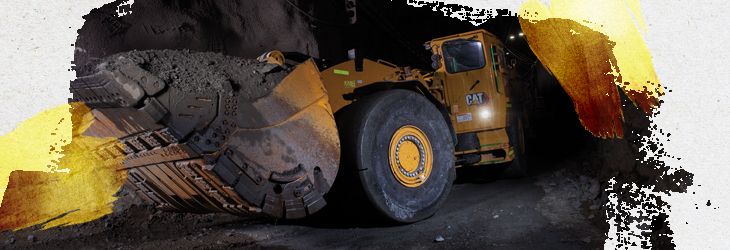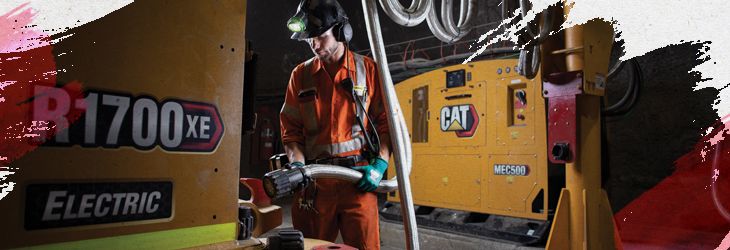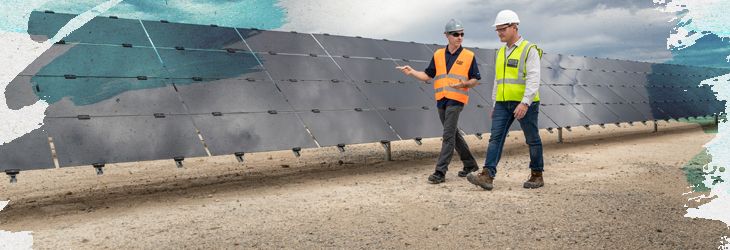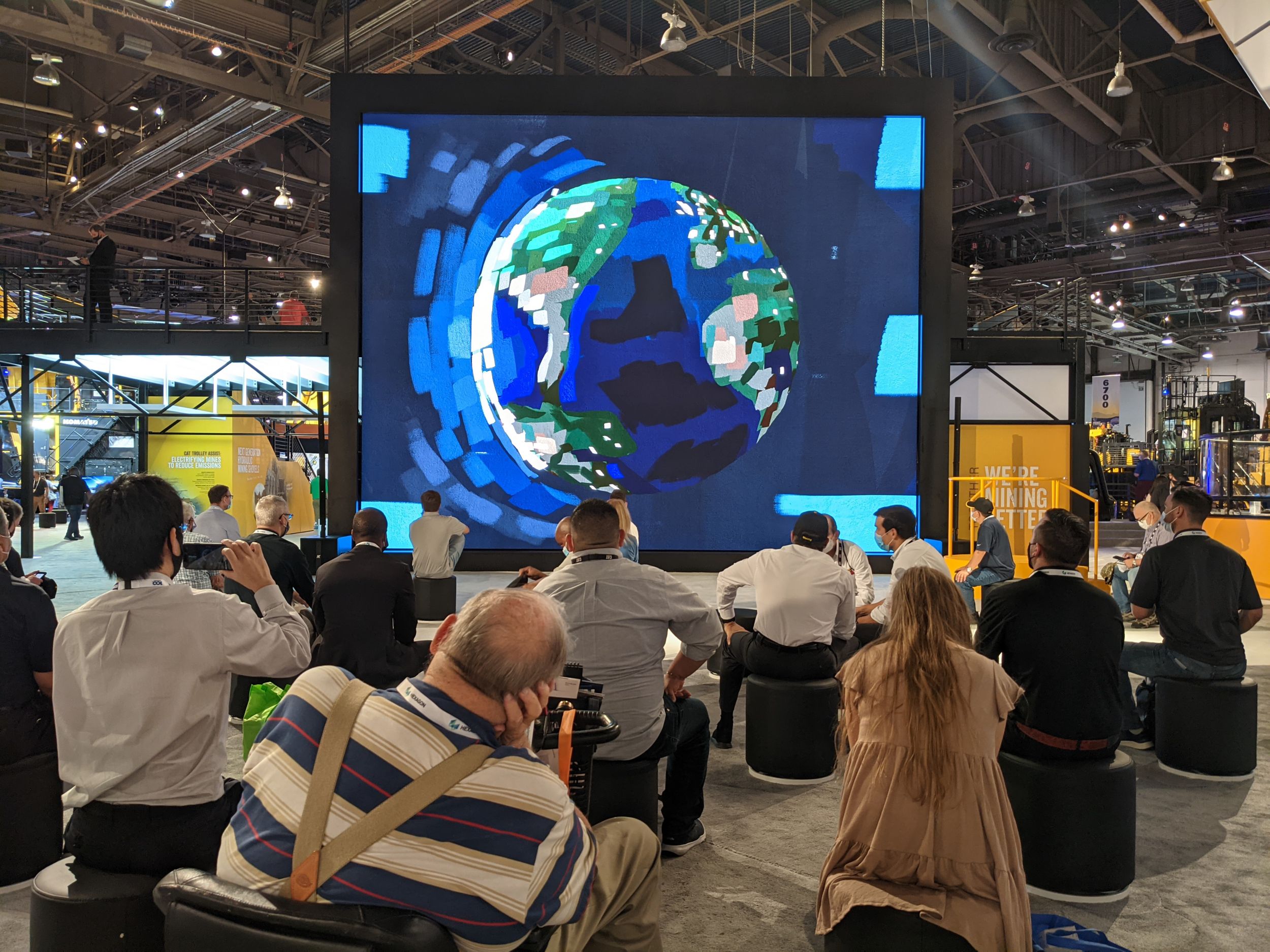

Sign In
Welcome! Sign In to personalize your Cat.com experience
If you already have an existing account with another Cat App, you can use the same account to sign in here
Register Now
One Account. All of Cat.
Your Caterpillar account is the single account you use to log in to select services and applications we offer. Shop for parts and machines online, manage your fleet, go mobile, and more.
Account Information
Site Settings
Security
Optimizing Operations & Minimizing Impact
The Caterpillar commitment to sustainable mining
By Caterpillar | Posted September 21, 2022
Caterpillar recently introduced its first battery electric vehicle for mining — an underground loader that promises to deliver the same productivity as its diesel counterpart, but with zero exhaust emissions.
While pausing to recognize the significance of the new Cat® R1700 XE LHD, the company is quick to point out that the new machine is just one of many ways Caterpillar works to help its mining customers meet their Environmental & Social Governance (ESG) and sustainability goals.
“The R1700 XE is a great achievement, and we’re proud to introduce it to our customers,” says Denise Johnson, Group President, Caterpillar Resource Industries. “It will serve as a building block to develop more zero-emission products in the future.”
Johnson reinforced that the new LHD is just one of many offerings that its customers can use to support their sustainability efforts. Caterpillar has a strategy that incorporates multiple solutions to help mines reduce their environmental impact. Many exist today, some are in development, and others are on the drawing board.

“We have a great team of people backed by investment in research and development that have a laser focus on discovering new ways to help our customers mine better,” says Johnson. “While we are focused on the future, we’re also committed to working with our customers to help them use our current solutions to reduce that impact today.”
When explaining the wide variety of offerings Caterpillar provides to help customers in the areas of sustainable mining, the company boils the solutions down to two key areas: optimizing the mining operation and minimizing the impact machines have on the environment.
“Really, there are two ways we can help our customers meet their ESG goals,” says Johnson. “First, we can provide solutions that help them optimize the way they work. The more efficiently and productively they operate, the less fuel they burn, the less energy they use and the less waste they generate.”
Secondly, the company focuses on making machines and power solutions more sustainable. “We’re continually innovating to develop new products that operate with reduced — or zero — exhaust emissions, and by developing power solutions that address climate-related challenges,” says Johnson. In its 2020 Annual Sustainability Report, Caterpillar made a commitment that 100% of its new products through 2030 will be more sustainable than the previous generation through collaborating with customers, reduced waste, improved design for rebuild/remanufacturing, lower emissions or improved efficiency.
Johnson points out that beyond the individual solutions the company provides, the company’s mining experience and integration expertise are key differentiators.
“We offer a breadth of machines, technologies, power and energy solutions, services and processes that can help our customers build a better world,” she says. “And we have talented people who work alongside them to bring it all together.”
“We take a full-site approach — whether we’re implementing our proven autonomous mining systems, helping mines transition to new energy solutions, providing machines that run on alternative fuels or that are powered by electricity, or delivering asset health and support services that maximize the life and performance of every machine on site.”
OPTIMIZING OPERATIONS
One of the best ways Caterpillar can contribute to its customers’ sustainability goals is by helping them continually improve the way they operate, says Johnson.
“A fully optimized mining operation will deliver the highest safety and productivity, lowest cost and least possible environmental footprint,” she says. “And there are many Cat offerings today that our customers can use to mine more efficiently.”
Maximized machine efficiency
Maximizing the efficiency of traditional power systems reduces fuel usage and leads to fewer emissions. Caterpillar has made advancements in overall fuel economy for diesel-powered machines, such as reducing machine weight to optimize payload, increasing speed to reduce cycle times, and offering power settings that include economy mode options.
“We also continue to introduce new diesel-electric machines that operate more efficiently in some applications, so they burn less fuel,” says Johnson. “And our diesel-electric engines serve as a building block for a future transition to battery-electric power.”
Autonomy and technology
Technology offerings, including autonomous mining systems, deliver significant benefits across the mining operation, from boosting safety and productivity to enabling more consistent and efficient operations. The result is also a decrease in fuel burn for a reduction in emissions.
Cat MineStar™ Solutions technology and autonomy offerings:
- Deliver consistent and more efficient operations to reduce fuel usage
- Enable higher machine utilization, for reductions in idle time and less wasted fuel
- Utilize dispatch algorithms to reduce idle time and bunching at the loading site for a decrease in fuel burn
- Incorporate machine health technologies and data analytics to maximize asset health and performance
Equipment lifecycle management
“Our mining customers are always looking for ways to maximize the value they get from their Cat machines,” says Johnson. “And while that’s always good for their bottom line, the more a mine cares for its equipment, the more efficiently it operates — which can reduce the overall fuel burn. And the longer machines last, the less waste is contributed to the environment.”
Caterpillar and Cat dealers have dozens of products, technologies, services and solutions that help mining operations get more from their equipment throughout its full lifecycle. In addition to hands-on maintenance and repair services and Customer Value Agreements provided by Cat dealers, Caterpillar also provides digital solutions, ecommerce offerings and applications for equipment monitoring that contribute to reduced fuel consumption.
“Managing the health of every asset ensures top performance that can lead to lower emissions,” says Johnson. “It also helps extend the life of consumables to decrease the amount of waste contributed to the environment.”
Rebuilding, remanufacturing and recycling
For more than 45 years, Caterpillar and Cat dealers have been rebuilding and remanufacturing parts, components and complete machines to increase the lifespan of equipment and reduce owning and operating costs. That approach is good for business and can be good for the environment.
“These solutions can have a significant impact — reusing instead of discarding, conserving energy, reducing waste, keeping nonrenewable resources in circulation for multiple lifetimes and minimizing the need for new raw materials,” Johnson says. “We’re also listening to our customers and investigating ways we can help them in their efforts to recycle end-of-life machines and components.”
Retrofits and upgrades
Retrofits and upgrades enhance and improve older machines to incorporate efficiency improvements and emission reduction solutions, and to keep them in production longer to conserve energy and minimize the need for raw materials.
“Similar to the benefits of rebuilding and remanufacturing, giving customers the opportunity to improve older machines is good for business and it can support our customers’ sustainability goals,” says Johnson.
MINIMIZING IMPACT
Just as there is no single solution that will enable every mine to meet its environment-related goals, there is no single solution when it comes to reducing — and eventually eliminating — machine emissions. Caterpillar is focused on helping customers achieve their climate-related objectives through a breadth of machinery and power solutions that contribute to lowering emissions.
Electrification
“Making it possible for mining equipment to be powered by electricity has been a focus at Caterpillar for many years,” says Johnson “We continue to leverage our expertise and are committed to building a broader range of electrified products that build on the legacy of our current offerings.”
Fully electric Cat machines rely on a single non-engine power source and produce zero exhaust emissions. Some electric machines are tethered to a power source. For example, a trolley assist attachment for Cat trucks allows the machine to make use of external power during a certain section of the haul road. When connected to the trolley system, the truck’s propulsion system is powered purely with electricity from the power grid, which delivers a 100% speed-on-grade improvement and can reduce exhaust emissions up to 60%.
Battery-powered vehicles are also fully electric but are not tethered to a power source. Instead they rely on a mobile fast charging system, the Cat MEC500.

“Our first battery-electric vehicle for mining, the R1700 XE underground loader, is paving the way for more machines to come,” says Johnson. “In addition to delivering powerful performance with zero exhaust emissions, its onboard battery solution is an industry first.”
Unlike other battery-powered machines, the R1700 XE features onboard batteries that boost safety by eliminating the need to handle or exchange batteries. It can also be fully charged in less than 20 minutes by using two of the MEC500 chargers.
Caterpillar electrification solutions also include the EMD™ Joule locomotive, a battery-powered, zero-emissions switcher locomotive that Progress Rail developed in collaboration with a key mining customer.
Power generation
To help its mining customers power their operations while meeting their climate-related goals, Caterpillar is focused on making traditional power sources even more efficient and fuel-flexible, pairing traditional power sources with new technologies in a hybrid format and replacing traditional power sources with stand-alone new technologies.
“Many of our advanced power offerings are already at work on customers sites, either complementing existing engines or as stand-alone power delivery systems,” says Johnson. “Other systems are in development.”
- Renewable fuels enable increased use of reduced-carbon options and hydrogen blends. Today, Caterpillar reciprocating engines are running on low-carbon-intensity renewable fuels including biodiesel, renewable diesel, biogas and landfill gas. Caterpillar offers a Dynamic Gas Blending conversion kit that can displace up to 85% of diesel fuel with natural gas. This solution has been recognized with the EPA Clean Air Excellence Award. The company recently announced that it will begin offering Cat generator sets capable of operating on 100% hydrogen.
- Fuel Cells utilize renewable hydrogen fuel as a scalable source of electric power. “We’re also exploring the opportunities within fuel cells powered by renewable hydrogen for stationary and mobile equipment,” says Johnson.
- Electric and hybrid powertrains employ an electric drive transmission with power components.
- Batteries power work with stored electrical energy.
- Microgrids integrate renewable energy sources into electric power systems. Microgrid pairs a generator with an energy storage unit, solar panels and advanced controls.
“We are innovating and integrating across products, systems and solutions to provide the advanced power that helps our customers achieve their goals for lower greenhouse gas emissions, energy flexibility and business sustainability,” says Johnson.

Power management
Beyond providing a variety of solutions that mining companies use to power their machines and their operations, Caterpillar is also focused on helping them manage that power — from dynamic and static charging systems for battery-powered vehicles to obtaining and storing energy at the mine level.
These solutions include purchasing renewable energy certificates and installing renewable energy sources, such as photovoltaics (PV) or a microgrid installation that combines PV with battery storage to supplement and offset electricity generated with diesel fuel at an off-grid location.
One significant contribution to alternative energy consumption is the operation of combined heat and power (CHP) systems to power facilities. CHP systems drive additional efficiency, reduce emissions and save costs.
“We’ll also work with our customers to address the many infrastructure decisions, variables and challenges that must be managed in real-time in a dynamic working environment,” says Johnson.
Machine emissions reduction solutions
Caterpillar has a broad lineup of U.S. EPA Tier 4/EU Stage IV, EU Stage V or equivalent products for North American, European and Japanese markets. These machines provide a 90% reduction in emissions (NOx and particulate matter) compared to Tier 3.
“We’re proud that we can offer these solutions,” says Johnson. “And by planning ahead, we were able to minimize design changes to our machines and maintain the reliability and performance our customers demand from their products.”
Every Tier 4 / Stage V engine is equipped with a combination of electronic, fuel, air and aftertreatment components, based on engine size, application and the geographic location in which it will work.
“We recognize that our customers want the cost-saving benefits of more fuel-efficient and fuel-flexible products,” Johnson says. “Modular offerings within our product lines allow customization of equipment to provide the optimal blend of technology and emissions profile that helps them achieve their climate-related goals.”
A COMMITMENT TO EVERY MINE
While environmental responsibility is always a key focus for mining, meeting ESG goals is more important to the industry today than it has ever been.
“With strict regulations already in place, and more stringent ones on the horizon, the transition to a low-carbon future is underway and the pressure to accelerate this transition is growing every day,” says Johnson. “Mining companies are looking for comprehensive solutions that help them achieve both their sustainability and business objectives. And we’re committed to helping them in this effort.”
Caterpillar has a long-standing commitment to sustainability, with a history of sustainable innovation spanning more than 95 years. “We share the concerns of governments and the public about the risks of climate change and support global efforts to mitigate its impact,” the company says in its 2020 Annual Sustainability Report. “We are committed to further reducing our own emissions while helping our customers meet their climate-related objectives.”
The list of Caterpillar offerings that can enable sustainability efforts is long, and it continues to grow as the company focuses on finding the right solution for every mine.
“We recognize that these solutions are not one-size-fits-all, so we focus on developing a comprehensive portfolio of offerings that enable our customers’ version of success — no matter the application, geography, economic profile, existing machine fleets and current technology solutions,” says Johnson. “Together with our dealers, we’re committed to being a partner throughout the journey — helping them meet their goals today and working together to build the sustainable mine sites of the future.”




